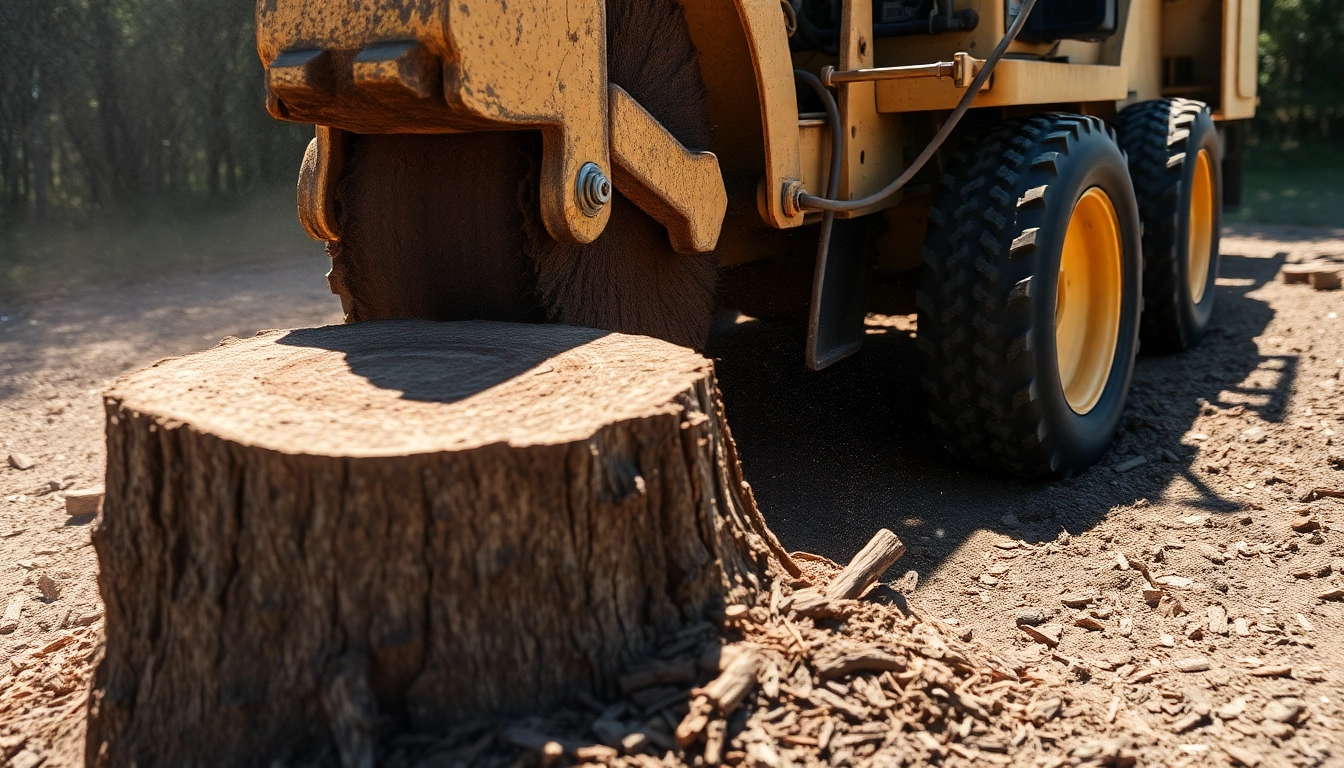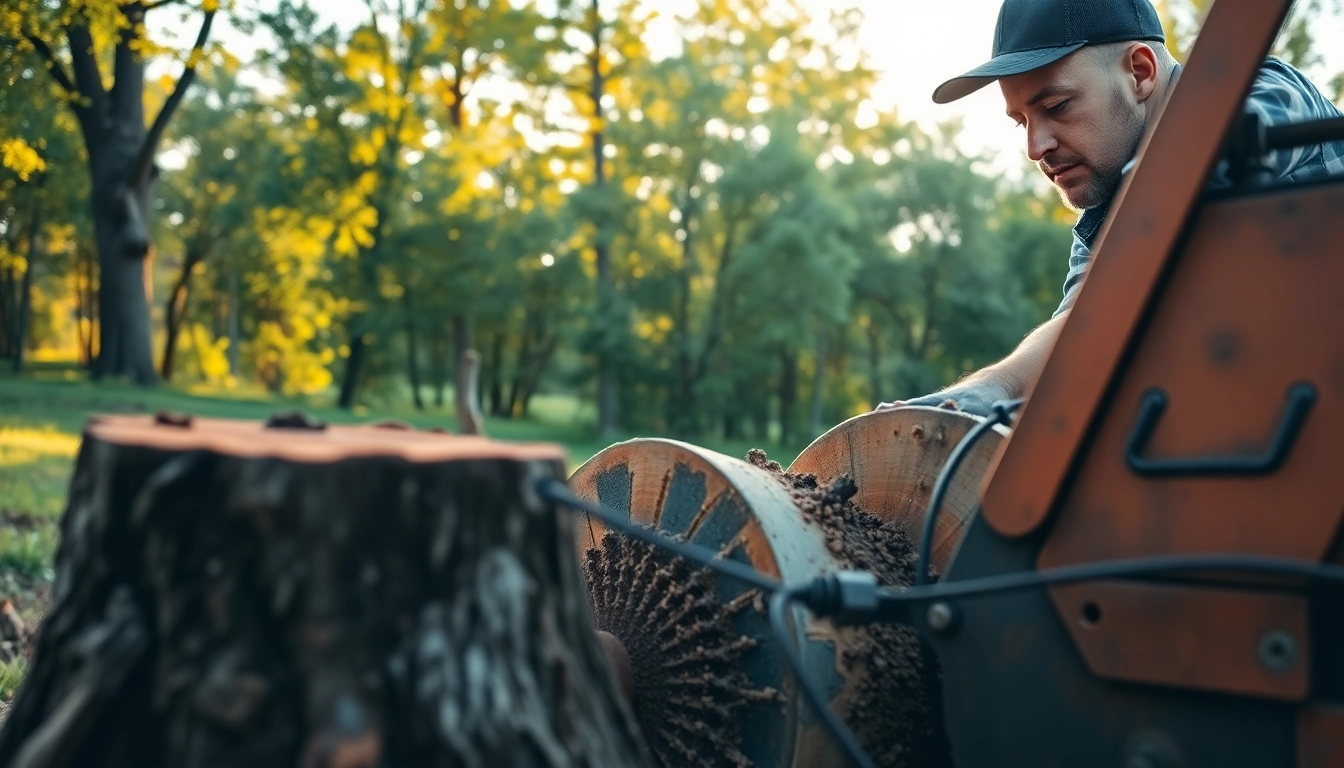Understanding Stump Grinding Services
What is Stump Grinding?
Stump grinding is a specialized process used to remove tree stumps from the ground after a tree has been felled. In this intricate method, a professional uses a machine known as a stump grinder, which operates with sharp blades that have the ability to break the stump down into small wood chips. This process not only eliminates the stump but also reduces the root system, making it an ideal solution for homeowners who wish to reclaim their yard space efficiently. Stump grinding is often chosen over traditional stump removal methods, which can be more invasive and labor-intensive.
Benefits of Hiring a Stump Grinding Service
Engaging a professional stump grinding service offers numerous advantages:
- Expertise: Professionals are trained to handle grinding equipment safely and effectively, minimizing the risk of accidents or damage to your property.
- Efficiency: A stump grinding service can complete the job much faster than DIY methods, thanks to their specialized equipment and experience.
- Reduced Risk of Pests: Leaving a stump can attract pests such as termites, ants, and beetles. Grinding the stump helps prevent these infestations.
- Improved Aesthetic Appeal: Stumping grinding provides a cleaner appearance in your yard, allowing for better landscaping options.
- Soil Health: The wood chips created from the grinding process can be used as mulch that enriches the soil once they decompose.
Common Stump Grinding Methods Explained
There are various methods for stump grinding, each with its own unique approach and benefits. Understanding these can help you choose the most suitable option for your landscaping needs:
- Traditional Grinding: This method involves using a stump grinder to grind the stump down to below the surface level, making it easy to cover with soil or sod.
- Chemical Stump Removal: Chemicals can be applied to accelerate decomposition, but this method takes longer and may not be suitable for all tree types.
- Excavation Method: Digging the stump out entirely is labor-intensive and can disrupt nearby plants, but it is effective for complete removal.
Choosing the Right Stump Grinding Service
Factors to Consider When Selecting a Service
When looking for a stump grinding service, consider the following important factors:
- Experience: Look for companies with extensive experience in stump grinding, as their knowledge can ensure the job is done correctly.
- Equipment Used: Inquire about the equipment they utilize; modern machines often complete jobs faster and safer.
- Insurance: It’s critical to choose a service that is fully insured to protect yourself from liability in case of accidents.
- Reputation: Check online reviews and ask for references to determine the company’s reliability and service quality.
Questions to Ask Your Stump Grinding Contractor
Before hiring a stump grinding service, it is essential to ask potential contractors the right questions to ensure clarity and confidence in their abilities:
- What type of equipment do you use for stump grinding?
- How long will the stump grinding process take?
- Will you provide a written estimate?
- Do you have the proper licensing and insurance?
- What is your method for debris disposal?
Comparing Quotes: What to Look For
When comparing quotes from different stump grinding services, look beyond the final price. Consider the following:
- Inclusion of Services: Ensure that the quote includes all services such as grinding, cleanup, and disposal of debris.
- Timeframe: Find out when the service can begin and how long they expect the project to last.
- Warranties: Check if the company offers any warranties for their work, which can provide peace of mind.
Best Practices for Stump Removal
Preparation Steps Before Stump Grinding
Preparing properly before the stump grinding process can streamline the job and enhance safety:
- Clear the Area: Remove any obstacles around the stump, including rocks, roots, and debris, to allow easy access for the grinder.
- Check for Underground Utilities: Use a utility locater service to mark the positions of any underground lines to prevent damage.
- Notify Neighbors: Let your neighbors know about the scheduled grinding to minimize disturbances.
Safety Measures During Grinding Process
Ensuring safety during the stump grinding process is essential. Here are key measures to implement:
- Protective Gear: Operators should wear safety goggles, gloves, and ear protection to shield themselves from debris and noise.
- Safe Distance: Ensure that bystanders maintain a safe distance during the grinding process to avoid potential injury from flying debris.
- Equipment Inspection: Regularly inspect the grinding equipment to ensure it is in good working condition before starting the job.
Post-Grinding Cleanup: What to Expect
After the stump grinding process concludes, you may anticipate a few cleanup steps:
- Debris Removal: Most professional services will remove excess wood chips and debris, but clarify this beforehand.
- Leveling: The area will typically need to be filled in and leveled with soil to restore the landscape.
- Mulching Options: You may choose to use wood chips as mulch or request that they be removed entirely.
Cost Factors for Stump Grinding Services
Average Pricing Structures for Stump Removal
The cost of stump grinding can vary widely based on several factors, but average prices generally range from $60 to $400 per stump. Factors influencing pricing may include:
- Stump Size: Larger stumps require more effort and longer grinding time, increasing costs.
- Location: Geographical factors and local market demand can also affect pricing.
- Access Difficulty: Stumps located in hard-to-reach areas may incur additional fees.
Additional Costs: What Can Affect Your Quote?
Beyond standard pricing, several additional factors can influence your stump grinding quote:
- Tree Type: Certain tree types, with denser wood, can be more challenging to grind and, therefore, more expensive.
- Root System Depth: Trees with extensive root systems may require more time and resources to grind down effectively.
- Site Preparation: If additional preparation is needed (such as clearing the area), this can increase the overall cost.
Cost-Saving Tips for Stump Grinding
Working within a budget doesn’t mean sacrificing quality. Here are some cost-saving tips for stump grinding services:
- Get Multiple Quotes: Shopping around can help you find competitive rates and potential discounts.
- Bundle Services: See if the company offers packages that include other landscaping services, as bundling might reduce costs.
- Timing: Off-peak seasons can offer lower rates, so inquire if any discounts apply during specific times of the year.
Long-Term Benefits of Stump Grinding
How Stump Grinding Enhances Your Landscape
Stump grinding doesn’t just eliminate a nuisance; it also brings long-term benefits to your landscape:
- Aesthetic Improvement: The absence of a tree stump enhances the overall appearance of your yard, making it more visually appealing.
- Expanded Yard Use: Removing a stump opens up space for landscaping, gardens, or recreational areas.
- Increased Property Value: A well-maintained landscape can positively impact property values, especially when planning to sell your home.
Preventing Pests and Diseases After Stump Removal
Proper stump grinding is key to preventing pest infestations and tree diseases:
- Eliminating Hiding Places: Stumps can attract insects and rodents. Grinding them removes their habitat and lowers the risk of infestations.
- Disease Management: Dead trees often harbor diseases. Stump grinding prevents the spread of pathogens to nearby healthy trees.
- Soil Health: The small wood chips produced during grinding eventually compost, enriching the soil without creating a habitat for pests.
Maintaining Your Landscape After Stump Grinding
Once stump grinding is complete, ongoing landscape maintenance is essential to ensure a healthy yard:
- Replanting: Consider replanting in the area vacated by the stump, ensuring that new plants fit the landscape design.
- Regular Care: Monitor the area for any remaining roots and manage soil quality to promote plant health.
- Mulching: Use the wood chips created from the grinding as mulch around new plants to retain moisture and suppress weeds.



